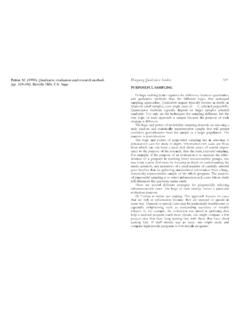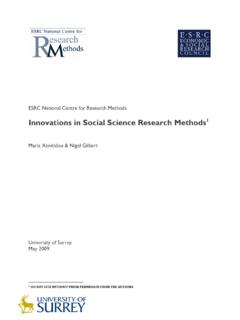Transcription of CHALLENGES TEACHERS FACE WITH INTEGRATING ICT …
1 CHALLENGES TEACHERS FACE with INTEGRATING ICT. with AN inquiry APPROACH IN MATHEMATICS. Anne Berit Fuglestad University of Agder During more than two decades Norwegian educational authorities have promoted the use of computers, calculators, and more recently, digital tools in teaching in general in various school subjects. This paper reviews efforts to use digital tools in TEACHERS '. and pupils' work and problem solving in mathematics within the frame of two research and development projects in six lower secondary schools in Norway. The analysis sets out to characterise and contribute to a deeper understanding of the CHALLENGES TEACHERS face with inquiry approach to mathematics. BACKGROUND AND RESEARCH QUESTION.
2 A brief history of ICT in Norwegian schools Since 1984 educational authorities in Norway have promoted the use of Information and Communication Technology (ICT) like such as computers and calculators in schools. Some TEACHERS and schools introduced computers on a trial basis in the 70's, but the major effort from educational authorities came with the Stortingsmelding 39, 1983-84 (KUF, 1984) which included a four-year plan of action to implement computer technology in some selected trial schools, starting in 1984. The aim of introducing computers was to learn about computer technology in society and to use computers as a teaching aid, particular attention was directed to vocational education and pupils with special needs.
3 A goal was to avoid introduction of new reasons to create differences between pupils. Emphasis was placed on introducing computers with software that represent new opportunities to support learning that other material or teaching aids cannot provide. A number of schools became experiment schools and were provided with equipment. Furthermore an office for coordinating and leading the effort was established on national basis. This happened at a time (1984) when micro computers were fairly new and with limited graphics, memory and processing capacity. To educate TEACHERS for use of ICT a course of 40 hours was offered and half year courses (30 ECTS) were developed for teacher education, but the content was dominated by programming, use of databases, and limited education about teaching with ICT.
4 The implementation of ICT as a teaching aid was not clear and purposeful. Let a thousand flowers bloom .. and find out what works seemed to be the idea. The first plan of action was later followed by new strategic plans for ICT in schools, and computer technology was built into national curriculum guidelines (UFD, 2004;. Krumsvik, 2007). Despite the official policy and initiatives the introduction of ICT in education has been slow in particular related to specific subjects (ITU, 2009). In the most recent curriculum guidelines, the Knowledge promotion in 2006. (LK06) facility with digital toolsi was made compulsory as one of five basic 1. competencies and to be used in all school subjects.
5 Furthermore, it is implied that use of digital tools will be accessible in examinations and the requirement that some test items have to be solved with computers. Access to and use of digital tools Recent surveys show that computers are now widely accessible in Norwegian schools and many pupils have their own portable computer, either private or provided by the local school authorities. On average there are pupils per computer in primary and lower secondary schools, and pupils per computer upper secondary schools. Internet is accessible from 90% and 98% of the computers respectively. Until recently use of digital tools, except calculators, has been limited in school subjects, and notably less in mathematics than in Norwegian, English and Social studies.
6 This is documented in biannual reviews of technology use in schools (ITU, 2010; Arnseth, Hatlevik, Kl vstad, Kristiansen & Ottestad, 2007). Furthermore, TEACHERS seem to be happy with learning digital competence through trying out themselves and getting guidance from colleagues. In mathematics a spreadsheet like Excel is the most commonly used software. Dynamic geometry like Cabri, and more recently Geogebra has become popular. Internet is used like in several subjects to search information and numerical data, from Statistics Norway, ( ). Drill and practice software is used to develop skills with number, perhaps most common with younger children. Recently computers have been introduced in the final examinations in mathematics in lower secondary schools, so far this is mainly the use of spreadsheets, and this raises the demands to use digital tools in teaching.
7 So, at the problems related to lack of equipment are mainly solved, and suitable software is available. The limited use of digital tools for mathematics teaching and learning indicates there is a challenge related to understanding and appropriate use of digital tools for teaching and learning mathematics. Related to this some questions arise: What is the role of ICT in learning mathematics? What is the nature of digital tools and how can they be utilised? This leads to the following research question related to teaching mathematics: Research question What CHALLENGES do TEACHERS meet in teaching mathematics supported by digital tools and to provide learning experiences with an inquiry approach for their pupils to develop mathematical understanding and skills?
8 Digital tools here are computers with open software. The question can be divided into several sub questions related to understanding of the role of digital tools in work and learning of mathematics, CHALLENGES related to the digital tools per se or related to organising computer use integrated in the mathematics classroom. In the following I will focus on the subject oriented use of computers with an inquiry approach to mathematics. The research question will be 2. investigated by reanalysing/ review cases from two projects on ICT in mathematics with regard to TEACHERS ' understanding of technology, mathematical representations and teaching approach. THEORETICAL BACKGROUND. Teaching in general and with digital tools particularly is a complex activity for the TEACHERS ; it involves deep insight in the subject, knowledge of the digital tools, and understanding of pupils' thinking.
9 Furthermore, it involves pedagogical approaches and relating these to the curriculum plans and policy involved and so on, all in a dynamic changing environment. Shulman (1986) introduced the term pedagogical content knowledge, PCK, to denote the intersection of pedagogical and content knowledge in order to consider the complex interaction between pedagogy and subject content. The mathematical content and pedagogy, including the teaching approach or considerations related to teaching a specific content or subject, cannot and should not be separated. For mathematics it involves for example how to approach particular mathematical ideas and processes and make the subject accessible for pupils, to understand common errors and various ways students think about the subject.
10 Ball, Thames & Phelps (2008) study teaching practice to understand what they call mathematical knowledge for teaching and found this knowledge is highly specialised for mathematics. The teacher needs to know more than to find a solution; they need to know various approaches and to be able to follow up pupils thinking. Mishra and Koehler (2006) extended Shulmans' model for teacher knowledge to include technology and introduced the term technology pedagogical content knowledge, TPCK, later recast as TPACK (Koehler & Mishra, 2009). Figure 1 (from ) indicates several areas of knowledge. In particular there is a need to understand and develop the knowledge related to technology and content TCK, technology and pedagogy TPK or how technology affords new approaches to teaching, and in the centre the integration and dynamic interplay of content, technology and pedagogy, and technology (Niess, Ronau, Shafer, Driskell, Harper, Johnston, Browning, zgun-Koca, & Kersaint, 2009)- Introduction of technology or more specific, digital technology, in teaching implies not just learning to handle the computers with software and other digital tools, but relating the technology to the other knowledge areas, pedagogy and content knowledge.




